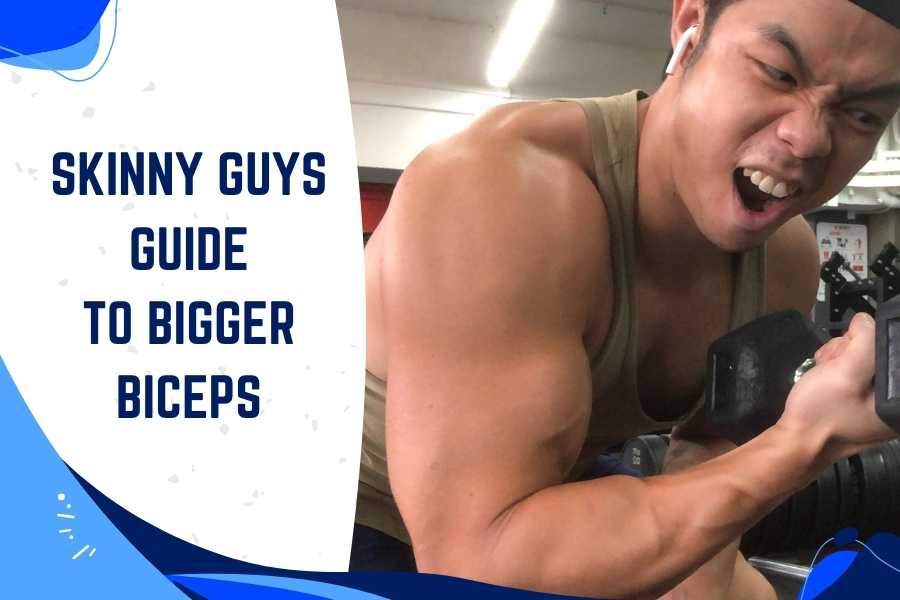Are you a skinny dude? Will your stubborn arms just not fill out your shirt sleeves despite your weekly bicep curls? Then look no further. Today, I will be guiding you through how to get bigger biceps!
Performing a variety of exercises that flex the elbows is the best way to increase biceps size. Popular movements include curls, pull-ups, and rows. Additionally, heavy weights should be lifted, and this should be combined with a good nutrition plan.
This post shares my favorite biceps exercises, a biceps workout you can do at home or the gym, training tips for fast gains, and nutrition basics to guarantee muscle growth.
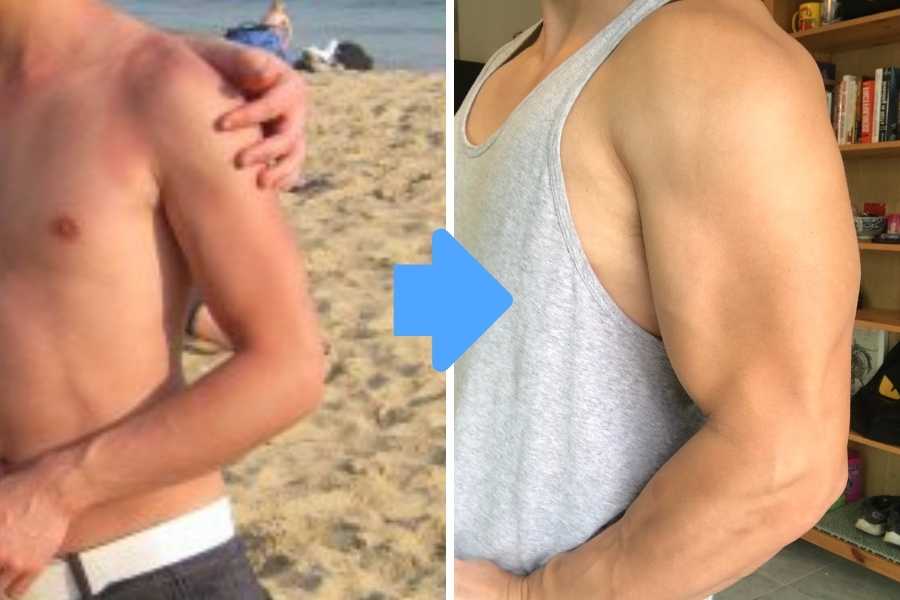
- Key Points Summary
- How To Get Big Biceps Fast
- 11 Best Exercises For Bigger Biceps
- Why Different Exercises Are Key To Building Biceps
- Skinny Guy Workout To Get Bigger Biceps
- Training Tips For Growing Big Biceps
- Can You Get Bigger Biceps At Home?
- Reasons Why The Biceps Can Be Hard To Grow
- Nutrition For Bigger Arms
- Estimated Timeframe To Get Bigger Arms
- Conclusion
Key Points Summary
- Growing the biceps is just like any other muscle. It requires intense weight training, a varied selection of exercises, and a bulking diet.
- The best bicep-building exercises flex your elbows. Examples include curls, rows, and pull-ups.
- Choose exercises carefully; the biceps comprise 3 muscles that are all emphasized with different movements.
- Biceps workouts should ideally have a mixture of compound and isolation exercises.
- Follow the training tips in this article for maximum biceps activation and growth.
- It is possible to grow your biceps at home if you have suitable equipment; dumbbells, bands, and pull-up bars are ideal.
- It should take around 3 months to see the first signs of biceps growth (assuming you are following a good training and diet program). The longer you train and bulk for, the larger your arms will get.
How To Get Big Biceps Fast

The good news for skinny guys is that we generally find it easier to put on muscle, compared to trained lifters. We can count on our newbie gains for that (a period of rapid muscle growth experienced by untrained lifters).
And speaking from personal experience, building noticeably bigger biceps naturally is completely possible. You don’t need steroids to reach your goal.
However, you DO need to avoid common arm training pitfalls. Here’s how to increase your biceps size fast in a nutshell:
- Choose the right biceps exercises. The biceps comprises 3 muscles; biceps brachii (long and short heads), brachialis, and brachioradialis. A carefully-chosen selection of movements is required to emphasize each muscle.
- Use a sufficient amount of weight. Lift at least 50%, and ideally 60-75%, of your 1-rep max on each exercise. You need to challenge your biceps in order for them to grow.
- Optimize training volume. A sufficient number of weekly sets and reps, training frequencies, and rest days need to be met for optimal biceps growth.
- Eat a suitable diet. Calorie and protein intake are required to fuel any type of muscle growth (also called hypertrophy).
Keep reading for more details!
11 Best Exercises For Bigger Biceps
I have decided to categorize my favorite biceps exercises into categories based on the equipment required.
This is because different types of equipment can challenge your biceps. All are effective. And most of the movements can be replicated with different types of equipment.
Additionally, some skinny dudes prefer to hit a commercial gym, whilst others like to train at home (you can check out my other post for a list of full-body home workouts).
Either way, you should be able to find a selection of suitable bicep-building exercises for your own personal situation!
Dumbbell Bicep Exercises:
Dumbbells are the classic go-to equipment to get bigger biceps. They’re space-saving, convenient, and allow for the greatest range of movement (ROM).
Different ROMs can be taken advantage of to target all of the stabilizers surrounding your biceps and challenge them for maximal growth.
1) Dumbbell curl
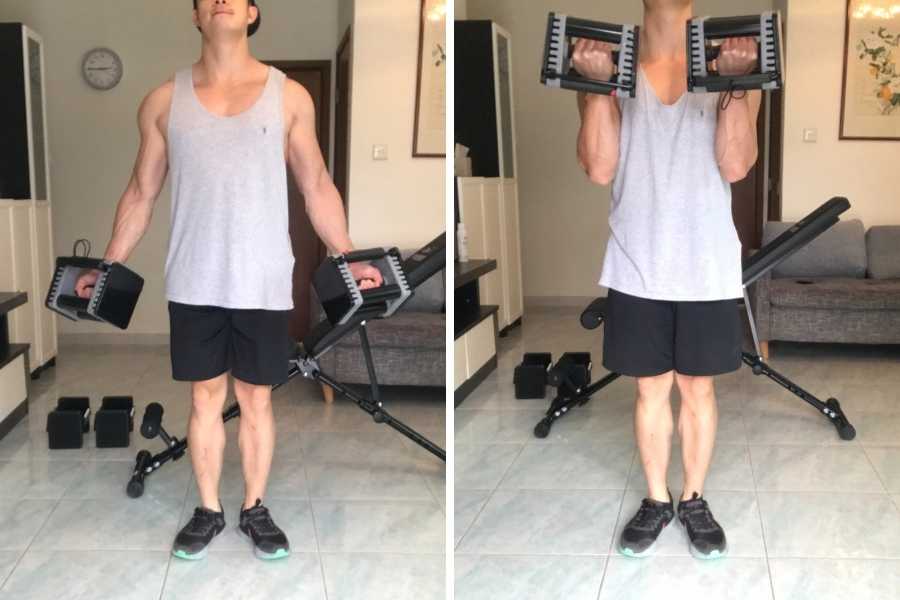
The classic bicep builder. Everyone knows this one.
Stand with a natural shoulder-width stance with dumbbells in both hands (underhand grip). Keep your elbows tucked into the body and make sure they do not flare out. Curl the dumbbells upwards whilst you exhale and hold the contraction for a split second. Lower the dumbbell in a slow and controlled manner.
I like to bend my knees, lean slightly forward, and contract my abdominals. This braces my torso and prevents the temptation to swing my hips out to cheat curl the dumbbell (which decreases muscle activation).
You can go to my other post for bicep curl weight standards according to your body weight, experience, and gender.
2) Reverse overhand dumbell curl
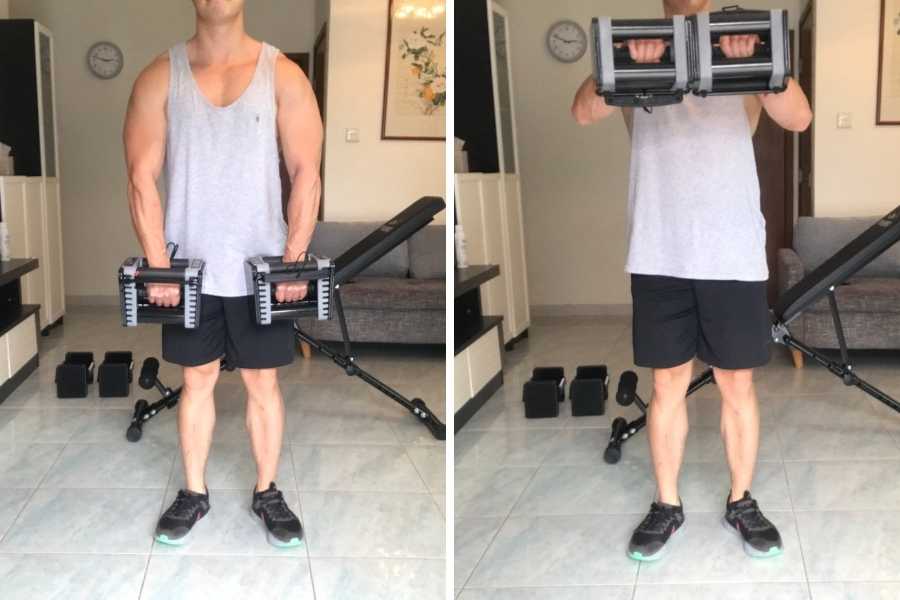
This curling variant is similar to the traditional bicep curl. The main difference is that you are holding the dumbbell with an overhand grip.
This exercise is much harder than the traditional dumbbell curl, so adjust the weight accordingly!
Reverse overhand curls are a great way to target the brachialis and brachioradialis stabilizers.
They also develop your overall grip strength since it is much harder to hold a dumbbell with an overhand grip.
3) Hammer curl
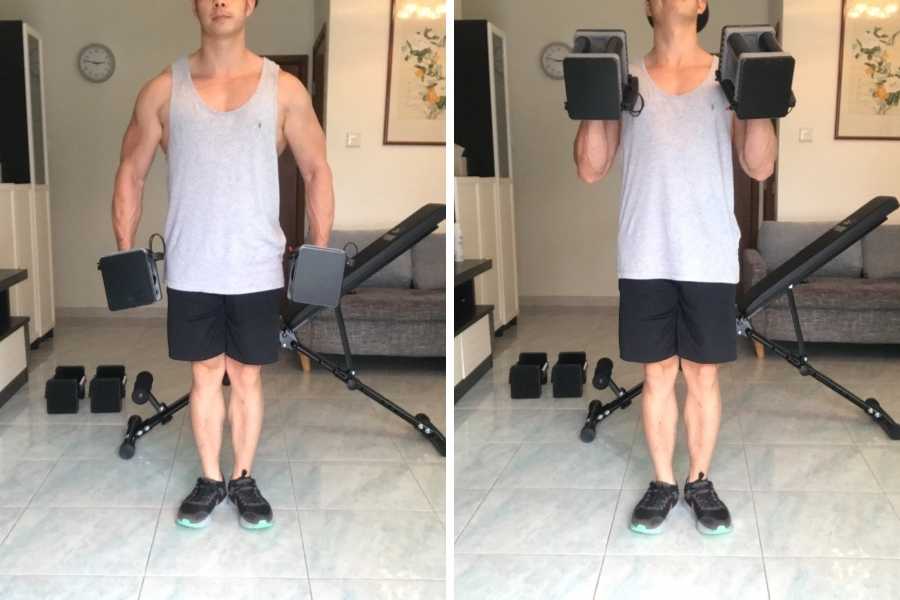
This is another variation of the traditional bicep curl.
Instead of holding the dumbbell with an underhand grip, rotate your grip by 90° (as if you are holding a hammer!)
This one is almost a hybrid between the traditional curl and the overhand reverse curl. However, it focuses the contraction on the long head of the biceps brachii, and brachialis.
I like to use the hammer curl to develop an overall bigger arm and forearm.
In comparison, the traditional bicep curl has more emphasis on a larger “bicep bulge” and focuses less on the forearm.
4) Incline dumbbell curl
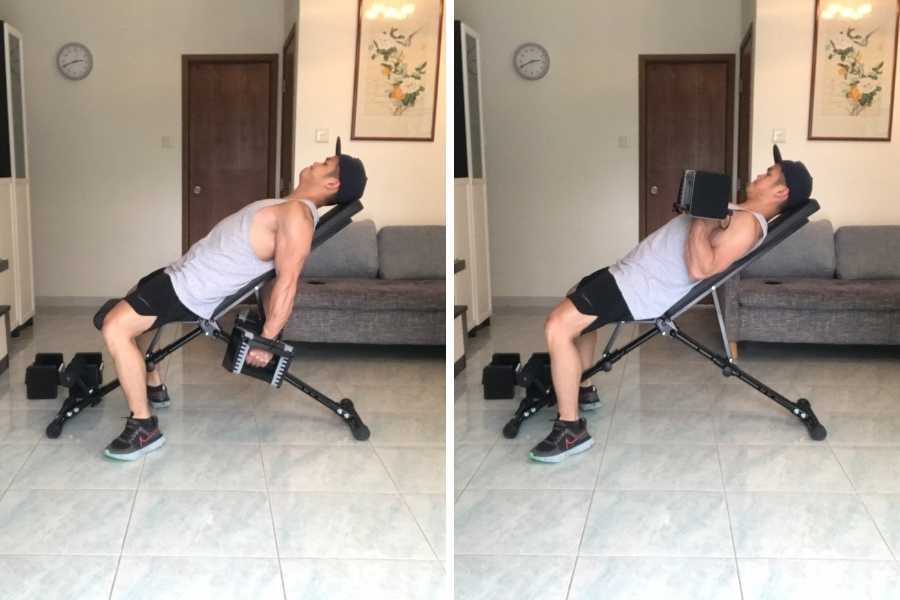
This curling variation requires an incline bench to perform. I use the Flybird FB149 (link for my review) which is affordable, foldable, and great value for money.
Set the bench at a moderate incline (65-45° is good). Sit on the bench with your back against the bench pad. Hold the dumbbells in each hand using an underhand grip. Curl the dumbbells up to the shoulders, before lowering them back down.
The incline is great because it extends the range of motion that your bicep has to contract. This stretches the bicep before it has even started working.
Combined, these two factors lead to a harder workout and a bigger bicep pump!
Barbell Bicep Exercises:
Barbells allow you to lift heavier weights, making them ideal for compound bicep movements.
As a skinny guy, I would first focus on developing form and technique using dumbbells before moving on to barbells (should you wish). You don’t have to if you don’t want to; dumbbells alone are effective at building the biceps.
In fact, dumbbells can be even better because the greater freedom of movement forces you to activate your stabilizer muscles.
5) Underhand Bent-Over Barbell Row.
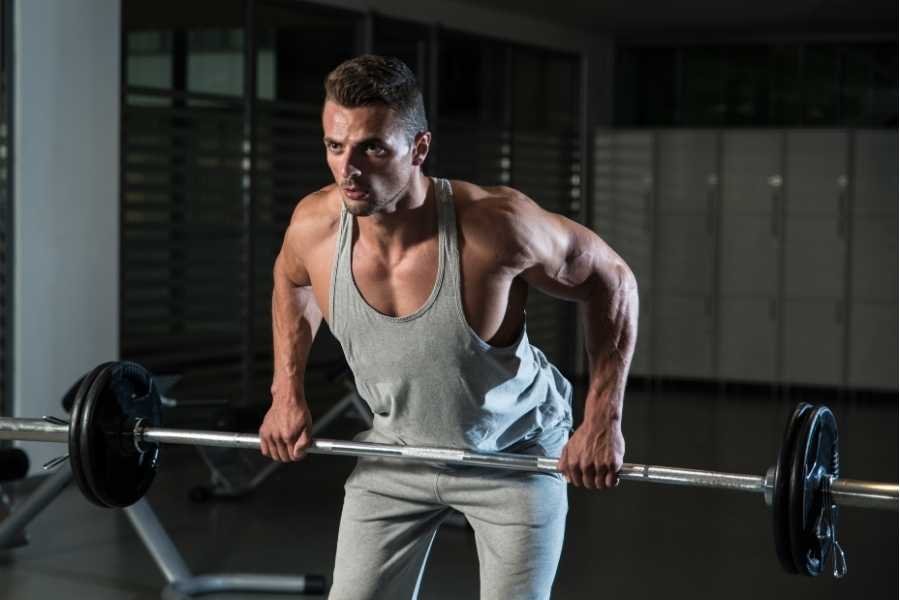
This is one of my all-time favorite compound exercises to get bigger biceps.
Many people don’t realize it, but compound pulling exercises, like the underhand bent-over row, are an excellent way to get bigger biceps. They provide a heavy-hitting new stimulus to challenge your biceps.
Not only do rows work your biceps, but they also help to broaden the back. And this will help skinny dudes to develop the coveted V-shaped body.
Load a barbell on the floor. Approach it with a shoulder-width stance. Bend the knees and grip the bar with an underhand grip, again shoulder width apart. Lift the barbell off the ground, making sure to keep the back straight and at a 45° angle to the floor. Row towards the navel. Lower the barbell.
Barbell rows can also be replicated using dumbbells. You can check my other post to find out the ideal weight for dumbbell rows to build muscle.
6) EZ Bar Preacher Curl.
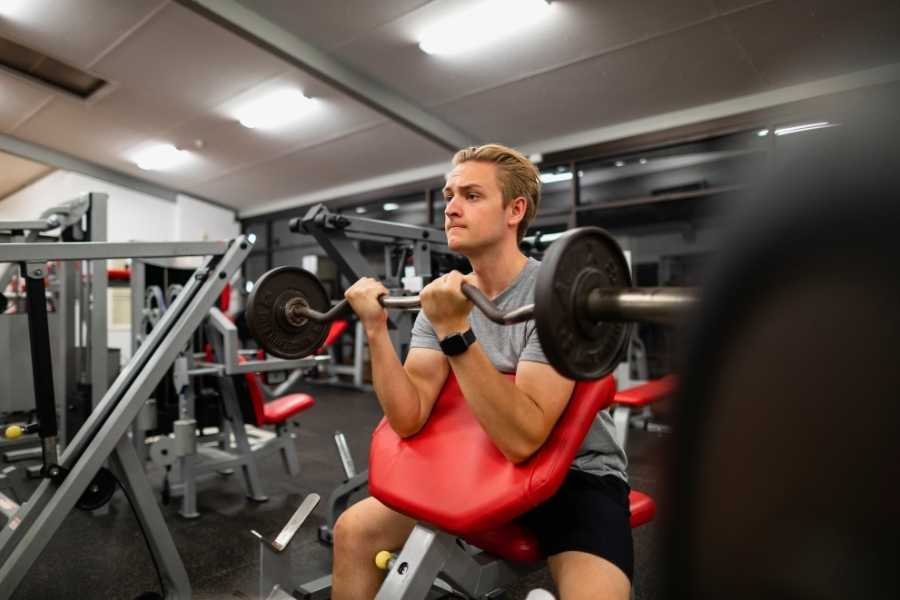
This exercise requires a preacher bench and an EZ bar.
Hold the EZ bar using the narrow grips. Sit on a bench and place your upper arms flat on the preacher pad. The bar should be held at arms-length (arms fully extended). Curl the bar upwards and hold the contraction for a split second before lowering the bar again.
The preacher curl has similar benefits to the incline dumbbell curl in that it extends the range of motion in the biceps.
I like to use the preacher bench to hit my biceps when all of the incline benches are occupied at the gym (which can be quite often during peak hours!).
Cable Bicep Exercises:
Cable machines are an awesome way to add variety to your bicep workout, providing a unique resistance profile compared to free weights (barbells and dumbbells).
Free weights produce the greatest resistance at the beginning of a lift and decrease towards the end. In other words, the curl becomes easier as the dumbbell approaches the shoulder. In comparison, cables provide consistent tension throughout a movement.
You can also replicate cable exercises with resistance bands. These provide another variation in resistance profile since the tension actually increases as the bands are stretched!
7) Overhead cable curl.
Commonly referred to as a crucifix curl.
Stand in between two cable-weight stacks. The cables should be set at shoulder height with D-grips attached. Grab each D-grip with an underhand grip. The starting position should be an upright body with both arms held out, parallel to the floor (your torso and arms forming a crucifix shape). Curl each cable simultaneously towards the ear. Return the cable back to the starting position.
This is a great variation of the traditional dumbbell curl mainly because the cable provides continual resistance throughout the curl.
Additionally, the crucifix position also prevents you from using shoulder momentum to “cheat”. Instead, you are forced to only contract the biceps!
8) Seated Underhand Cable Row

This is a variation of the bent-over barbell row. Instead of bending over, you are sitting upright. And instead of using a barbell, you are using a cable!
Sit on the seat of a cable row machine. Attach a bar handle and grab with a narrow underhand grip. Keep your back and legs straight whilst pulling the bar towards the torso. Hold the contraction for a second when the bar reaches the torso, contracting your shoulder blades for maximal effect. Extend the arms slowly to return the bar to the starting position.
Similarly to the bent-over barbell row, the seated cable row is another great compound movement to develop your arms as well as the back (for a V-taper body).
Different grips and handles can also be used to target the different bicep muscles. But for the greatest bicep targeting, always stick with a neutral or underhand narrow grip.
Bodyweight Bicep Exercises:
Body weight exercises are an excellent way to get bigger biceps without dumbbells, barbells, or cable machines.
These exercises are ideal for skinny dudes who prefer to work out at home, but don’t yet have gym equipment.
I do recommend getting a home pull-up station though. These can be found cheaply on Amazon. Pull-ups and chin-ups are arguably THE best bodyweight bicep-builders.
9) Overhand pull-up
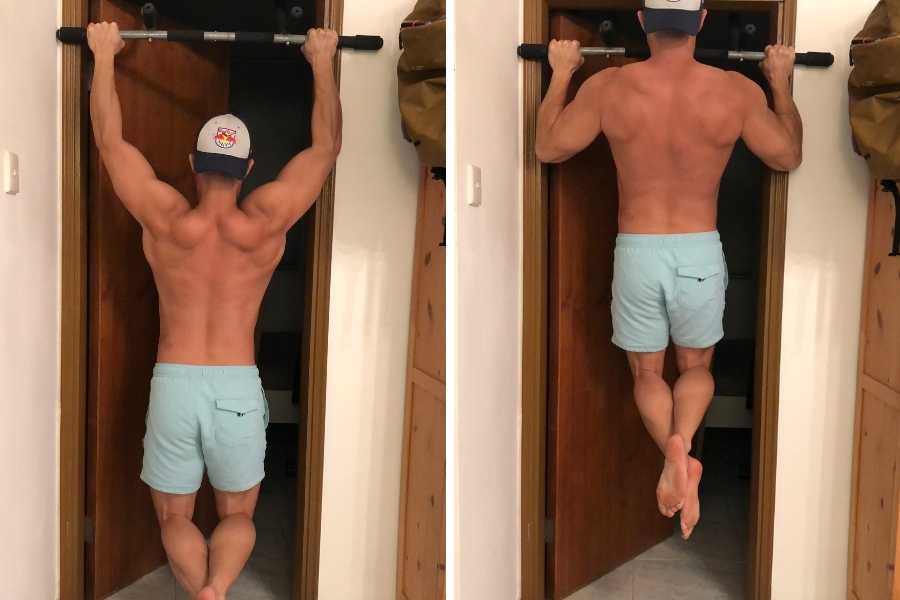
The traditional pull-up with a shoulder-width overhand grip is primarily a back exercise working the lats.
But the compound nature of this movement also means it can effectively work your biceps too.
Grab a pull-up bar using an overhand grip spaced just wider than your shoulders. Hang from the bar and brace your torso. Retract your shoulder blades and pull your chin towards the bar (focus on pulling with your back rather than just your arms. Stop when your chin reaches bar level before lowering yourself back down.
Weighted pull-ups are one of my favorite muscle-building exercises (you can check the link to see how much weight to add to your pull-ups).
10) Underhand narrow-grip chin-up

The underhand narrow-grip chin-up is an awesome pull-up variation that shifts the emphasis onto the biceps.
In fact, they are probably my favorite exercises to build bigger biceps and an exercise that I credit for my own skinny-to-muscle transformation.
Begin by hanging from the bar with a narrow grip. If you are a beginner, use a step or box to slowly lower your body weight onto the bar. This will prevent shoulder injury which could occur from a jumping start. Pull the body towards the bar. Lower the body when the chin reaches the bar. Remember to lower the body slowly (don’t let gravity do the work!).
Not only does this pulling exercise challenge the biceps, but it also engages the back muscles for a broader upper body.
Chin-ups can be difficult for beginners though. So I would recommend aiming for 2 to 3 (or however many you can do) to start with and build from there.
11) Towel curl
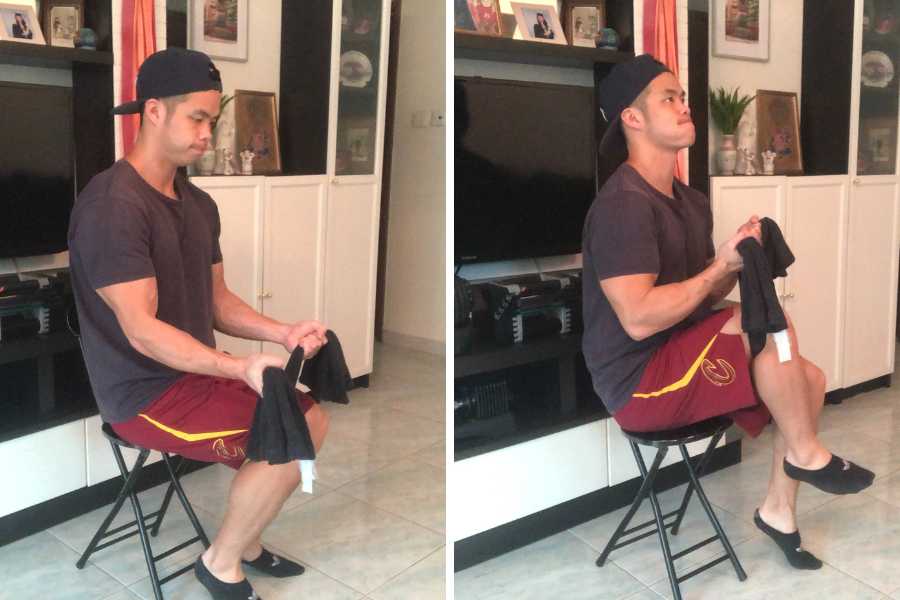
This may sound a bit strange to some- and it’s by no means a replacement for free-weight curls- but the towel curl works.
Yes, you can replicate dumbbell curls using just a mere towel.
Grab a towel and twist it around itself lengthways. This forms a “towel rope”. Take a seat on a chair and step onto the middle of the towel rope. Use both hands to grab both ends of the rope, and curl. You are basically using your leg as a weight!
Don’t be fooled by the simple nature of this exercise, your leg is a pretty heavy body part!
Additionally, gripping a towel can be awkward, and this will help work your forearms and develop grip strength.
Why Different Exercises Are Key To Building Biceps
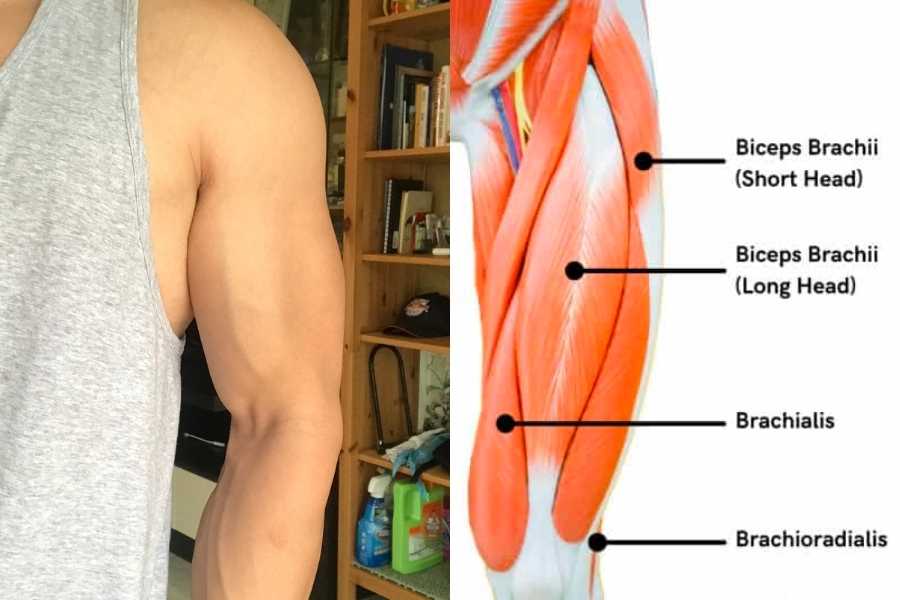
What most people refer to as the “biceps”, are actually 3 component muscles. And training all 3 bicep muscles is essential to upgrade those guns.
This is why you need to choose a selection of bicep exercises to for balanced arm development. In fact, poor exercise selection is one of the biggest mistakes people make when it comes to building arms.
And don’t forget to work the triceps too. Remember, they constitute two-thirds of your arm!
Bicep muscles to train:
1) Biceps Brachii
This is the large muscle that runs along the top of the upper arm. The biceps brachii accounts for most of the visible muscle mass in large biceps.
It’s actually composed of two smaller muscles- the long head and the short head. These both work together to flex and rotate the forearm.
All of the biceps exercises mentioned in this post will work the biceps brachii to some degree.
2) Brachialis
This broad muscle lies underneath the biceps brachii. If you look closely, you will notice that lean guys with big biceps will have two distinct bulges. The smaller bulge is the brachialis!
Its job is to flex the forearm at the elbow. Although it may not be as visible as the biceps brachii, it actually generates most of the power during a forearm flex.
Movements that keep your palms in a neutral position (facing inwards and dancing each other) are best for emphasizing the brachialis. Examples include the pull-up and hammer curl.
3) Brachioradialis
The brachioradialis is a smaller muscle that runs along the length of the forearm.
Its job is to help flex and rotate the forearm at the elbow. It also stabilizes the elbow joint during curling movements.
Training the brachioradialis is essential if you want your forearms to grow with your biceps!
Most bicep exercises will work the brachioradialis. Overhand bicep curls are of the best.
Skinny Guy Workout To Get Bigger Biceps
Below, is one of the simplest, but best, bicep workouts that worked for me. It’s designed to slot into your current 3-day training split.
Simply perform the workout each day in conjunction with your current 3-day program. Do not repeat exercises that already feature in your current program though (each workout is standalone).
For example, if your current workout already features back and arm exercises, then simply replace them with the exercises detailed below.
Day 1:
| Exercise | Sets | Reps | Weight | Rest Between Sets |
|---|---|---|---|---|
| Chin-ups | 3 | 6 | 85% 1RM | 2 mins |
| Barbell rows | 3 | 8 | 80% 1RM | 2 mins |
| Hammer curls | 2 | 10 | 70% 1RM | 2 mins |
Day 2:
| Exercise | Sets | Reps | Weight | Rest Between Sets |
|---|---|---|---|---|
| Pull-ups | 3 | 6 | 85% 1RM | 2 mins |
| One-arm dumbbell row | 3 | 8 | 80% 1RM | 2 mins |
| Dumbbell curls | 2 | 10 | 70% 1RM | 2 mins |
Day 3:
| Exercise | Sets | Reps | Weight | Rest Between Sets |
|---|---|---|---|---|
| Chin-ups | 3 | 6 | 85% 1RM | 2 mins |
| Barbell rows | 3 | 8 | 80% 1RM | 2 mins |
| Reverse overhand curl | 2 | 10 | 70% 1RM | 2 mins |
All 3 workouts combined will work all biceps muscles with a sufficient volume to promote optimal growth.
See next for workout tips to make the most out of the workout plan and explode those guns!
Training Tips For Growing Big Biceps
These 10 training tips helped me to personally grow my own biceps. They will maximize the results from any bicep workout and help you to transform your skinny arms!
1. Hit The Biceps At Different Angles!
As you now know, the bicep is composed of 3 distinct muscles. Therefore it makes sense to hit all three muscles right.
Ryan and Eric Johnson from Muscle and Fitness explain that hitting all the different muscle fibers in the arm will stimulate the most muscle growth.
This can be done by varying the angle of the body during a given exercise (e.g. incline and decline bicep curls).
Alternatively, you can incorporate different types of bicep exercises into your training program to ensure all angles are covered (see below for my favorite bicep blasters).
My workout program will typically include working on 3 different bicep exercises every week. Each workout will include at least one bicep isolation exercise. I will then switch the exercises every week.
This allows me to hit all my bicep muscles each and every week!
2. Increase Bicep Training Volume.
Training volume is a term that describes the total weight you are lifting for a particular body part. In this case, it would be the biceps!
Training volume is calculated by multiplying the number of sets x reps x weight.
When you increase training volume, you also increase the workload put on the biceps. And this will promote muscular hypertrophy!
Be careful not to overdo it though. In fact, overtraining is also counter-productive, as it prevents muscle recovery (and therefore growth).
Mike Dewar from Fitbod recommends training the biceps with 12 to 20 sets per week for intermediate lifters. You can get away with 6 to 8 sets per week if you are also doing compound pulling exercises in your training program.
I prefer the latter method since most of my compound pulling exercises also give my biceps a good workout too!
3. Use Lighter Weights With More Reps.
Heavy lifting has traditionally been associated with maximal muscle growth.
However, when it comes to the arms, many trainers vouch for the opposite. That is to use lighter weights with higher reps.
Bojana Galic from Live Strong recently interviewed Maillard Howell (trainer and founder of The Beta Way). And here is what Maillard had to say:
“Incorporating a large variety of biceps exercises performed with high sets and high reps will also help you build bigger arm muscles.”
Maillard Howell
In this instance, a high rep would be in the 10 to 15 rep range.
In other words, perform 10 to 15 reps per set using a lighter weight! This will really get the blood pumping to the biceps.
I have personally tried this strategy, and can honestly say my arms feel more pumped compared to lifting heavier weights with low reps.
4. Allow The Biceps Enough Rest Time In Between Sets.
High-intensity weight lifting with limited rest time between sets is great if you want to burn fat.
However, as a skinny dude, you are probably not looking to burn fat. Rather the opposite- you are trying to gain muscle!
As Damian Soong from Form Nutrition explains, it’s essential to allow your muscles sufficient time to rest between sets.
This was shown in a 2017 study that demonstrated that resting for over 60 seconds is optimal for muscular hypertrophy (muscle growth) when compared to resting under 60 seconds.
This is because higher rest times allow you to increase training volume!
Damian recommends a 2 to 3-minute rest for trained individuals, and this is how long I rest during my bulking workouts.
However, for newbies, Damian recommends resting for as long as you need to.
5. Let The Biceps Rest Between Workouts.
In addition to sufficient rest between sets, make sure you let your biceps rest between workouts!
This is especially important for skinny dudes who may not yet have any significant muscle mass. You don’t want to overtrain!
Dr Neal Malik from Old Podcast recommends allowing at least one off day a week for your muscles to recover. If you are new to weight training, then 2 days are recommended.
Remember, the bicep is a muscle. And like any muscle, it needs adequate rest to rebuild. And when you give your biceps time to rebuild, they will come back bigger and stronger!
I personally allow my biceps to have a full day’s rest between workouts. However, I also remember allowing 2 to 3 days rest when I first started working out.
Remember, you can always target the other muscle groups on your rest days.
The important thing is to listen to your body and push it within your own boundaries.
6. Work The Biceps With Compound Exercises.
One of the most common reasons why people stay skinny is because they do not do enough compound lifting.
Compound pulling is a great way for skinny guys to simultaneously work the biceps and other muscle groups. A classic two-birds one stone situation!
Additionally, compound exercises allow more weight to be lifted, further increasing your bicep training volume. And this will add serious mass to a skinny arm.
Furthermore, Eric Valzquez from Mens Journal explains that increasing weight load will also promote muscle-building hormones (testosterone, human growth factor, and insulin-like growth factor-1).
I personally live by compound lifts. They allow me to work my biceps with heavy weights whilst simultaneously engaging my other muscles.
My compound recommendations for bicep growth? Underhand pull-ups and barbell rows!
7. Concentrate on Form To Maximise Bicep Contraction.
Maintaining proper form when weightlifting is so important, especially for skinny guys who have a naturally weaker frame.
Not only does proper form reduce injury likelihood, but it will also facilitate maximal bicep contraction. And maximal contraction means maximal muscle gains!
In an interview with Coachmag, trainer Joel Dowey recommends working your biceps across a full range of motion during a bicep curl.
In other words, extend the forearm to its maximal point before curling the weight back up.
This allows your bicep to reach maximal elongation and contraction.
Joel’s top tip is to flex your triceps at the bottom of a curl. And this will force you to achieve a full range of motion.
I’ll be the first to admit that in my early training days, I would sacrifice form for weight load. I would swing my hips to hoist the dumbbell upwards, and then let it fall back down uncontrollably. All for the sake of lifting heavier.
What a rookie error! Since utilizing Joel’s advice, I am now able to curl heavier weights and my biceps have also grown larger!
You can check out my other post to learn how to choose the right dumbbell weight to build arm muscle.
8. Increase Bicep Size With TUT.
Time under tension training (TUT) is a great way to increase the blood flow to your muscles and thereby stimulate bicep growth.
TUT is a training method that involves slow and controlled movements in both the concentric and eccentric phases of a lift. In other words, lift the weight slowly on the way up, and slowly on the way down!
Additionally, you will be lifting a lighter weight during TUT.
Mike Matthews from Legion Athletics raises an important point though.
To gain the maximal hypertrophy results, you should lift a sufficient weight (Mike recommends ~60% of your one rep max). In other words, don’t go too light!
Furthermore, make sure you increase the weight when the movement becomes too easy (also called progressive overload).
TUT can be a particularly suitable way for skinny guys to begin growing their biceps.
Why?
Bicep exercises tend to be isolated lifts. This can put a lot of stress on your elbow joint. And as a skinny dude, your joints may be particularly susceptible to joint stress.
Since TUT training advocates lifting lighter weights, the lifts will be less stressful on your joints.
Don’t let the lightweight nature of TUT fool you. You can get an incredibly powerful bicep pump just by lifting slowly!
I actually do TUT bicep work just before a big night out with friends for this exact reason (I’m sharing this information with you only!).
9. Work The Bicep Stabiliser Muscles!
The stabilizer muscles are those that stabilize a movement. This is in contrast to the primary movers which serve to drive the movement.
In the example of a bicep curl, the primary mover would be the biceps brachii, and the stabilizer role is provided by the brachialis and brachioradialis.
As Brandon Hall from Stack explains, working on your stabilizers will not only reduce injury risk but will also allow you to lift heavier weights too.
I’ll be honest- I rarely worked on the bicep stabilizers during my early lifting days (I wanted to pump heavy, not work on stabilizers!).
But now I make an active effort to incorporate lifts that engage the brachioradialis (reverse overhand bicep curls are great!). And I highly recommend you to do so as well.
As an ex-skinny guy, I can tell you that it will help add definition to your arm in general, and allow you to curl heavier in the future!
10. Hit The Bicep Fast Twitch Fibres!
Fast twitch fibers are a class of muscle fibers responsible for fast and explosive movements. In comparison, slow twitch fibers are responsible for endurance-type movements.
Stacey Penney from NASM explains that fast twitch fibers are not only larger, but they also experience greater rates of growth in response to weight training.
As a skinny guy trying to build your arms, this is exactly what you want!
But how do you target the fast twitch fibers in the biceps?
Natalie Dunn from Recoup Fitness recommends lifting heavy and with explosive power.
Personally, I like to dumbbell curl at around 70% one rep max. I will curl explosively upwards, before lowering the dumbbell back down slowly.
This allows me to hit the bicep fast twitch fibers whilst incorporating aspects of TUT as well!
Bonus Tip: Include Tricep Exercises For Bigger Arms!
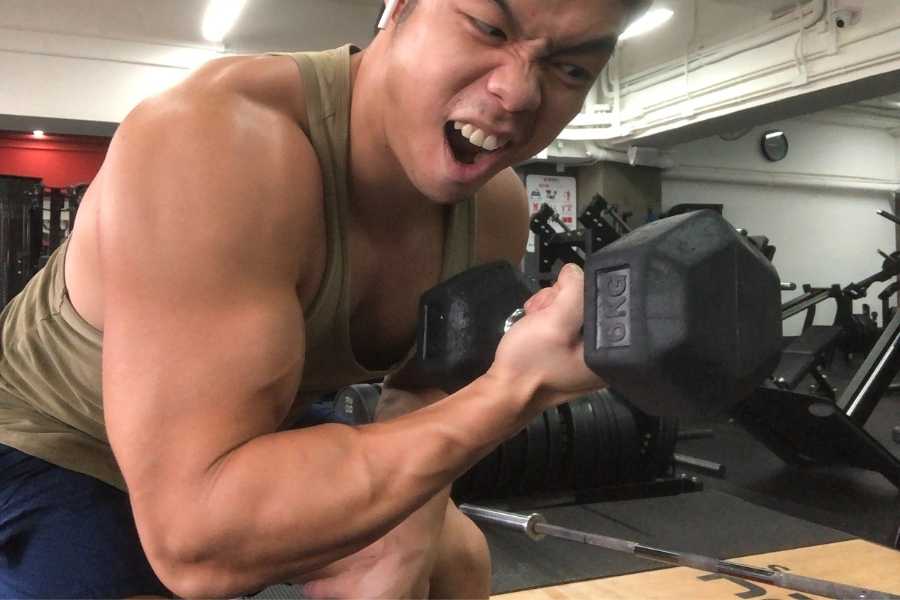
By now, you know that the biceps consists of 3 major muscles. But did you know that the tricep is actually the larger muscle of the two?
Yes, the tricep is usually larger than the bicep. therefore it makes sense to spend some time on the triceps too!
As Chris Ruden from Breaking Muscle rightly points out, many people will focus on the biceps and completely ignore the triceps.
Don’t make this mistake if you want to develop powerful arms!
Compound lifts such as the narrow-grip bench press, overhead press, and dip are great ways for skinny dudes to develop their triceps.
Isolated lifts such as arm extensions can then be used to add further definition.
Can You Get Bigger Biceps At Home?
Procedures for increasing bicep size at home and at the gym are similar. Intense resistance training focusing on movements that flex the elbow, combined with a good nutrition plan, are essential for building bigger biceps.

I’ve already shared the best biceps exercises to grow your arms. Most of these exercises can be replicated using:
- Barbells.
- Dumbbells.
- Kettlebells.
- Resistance bands.
The main difference between training at home and at the gym fall down to the equipment you have available.
Most gyms have a full array of free weights and machines. This is something most people do not have at home.
In this scenario, I recommend getting a pair of high-quality heavy adjustable dumbbells as the most cost-efficient way to build muscle at home.
An even cheaper alternative is to get a set of heavy resistance bands like these Undersuns (link for my review).
Finally, you can even build big biceps at home using bodyweight exercises like pull-ups, chin-ups, and towel curls.
If you’re interested, you can check out my other post for a home dumbbell workout routine to build full-body muscle, including the biceps!
Reasons Why The Biceps Can Be Hard To Grow
Most people struggle to grow their arms. Indeed, I polled multiple Reddit and Quora threads to find that the biceps is one of the hardest muscles to grow for many people.
Here are the most common reasons why you may find your biceps hard to build:
- Insufficient training volume. Ensure your biceps receive 10-20 weekly sets working in the 8-15 rep range.
- Not lifting heavy enough. Make sure you’re lifting at least 60% of your 1RM for a given exercise.
- Lack of exercise variety. Include a variety of compound and isolation movements from my list of bicep-building exercises.
- Poor nutrition. See the next section.
If you’re biceps just won’t grow, you can also refer back to my 11 arm training tips detailed in the previous section for more details.
Nutrition For Bigger Arms
If you want to grow those biceps, then training is half the battle!
You will also have to ensure that your diet will provide sufficient energy to fuel muscle growth.
Furthermore, this is particularly important for skinny guys, who tend to under-consume their daily calories
Here are 3 ways to make sure that your body has enough resources to build big biceps.
1) Eat A Caloric Surplus To Build Muscle
For your body to build muscle, it needs to be in a state of caloric surplus.
This simply means you are consuming more calories than the body is expanding.
And when you are in a caloric surplus, the body diverts the extra energy into building muscle.
In general, I would suggest that you do not focus your efforts on purely building bigger biceps.
Instead, aim to build muscle throughout the whole body. This will ensure proportional body development.
In this instance, aim for a mild to major caloric surplus of +5 to 15% more than your daily maintenance calories (the higher the surplus, the faster you will build muscle).
If you are dead set on just building bigger biceps, then I would recommend a minor caloric surplus. This will allow your body to build bigger biceps with minimal fat gain.
2) Increase High-Protein Food Intake To Build Arm Muscle
Protein is a macronutrient that is essential for muscle growth.
You should aim to consume 1.2-1.6 grams of protein per pound of body weight (daily).
This will ensure your body has enough resources to build bigger biceps!
High-protein foods to help increase your arm size with minimal fat gains include:
- Lean beef cuts like sirloin.
- Lean pork cuts.
- Chicken breast.
- Egg whites.
- Fresh white fish like cod.
- Oily fish like salmon.
- Tinned fish like tuna.
- Legumes like kidney beans.
- Nuts and seeds.
- Soy milk.
3. Eat Complex Carbohydrates To Fuel Bicep Workouts.
Eating enough carbohydrates is equally important as consuming enough protein.
This is because carbohydrates provide energy to your muscles. And the more energy you have, the harder you can work those guns!
Aim to consume a nutritious meal a couple of hours before a workout. This pre-workout meal should be packed with high protein and complex carbohydrates.
Complex carbohydrates include potatoes, pasta, and whole grains.
I would also advise eating the same for your post-workout to fuel arm muscle repair and recovery.
Estimated Timeframe To Get Bigger Arms
Assuming you’re following a good workout and nutrition plan, it should only take a few months before you start seeing the first visible signs of muscle growth.
Here’s an approximate timeline of results:
| Time | Expected Bicep Circumference Gains | Visible Results |
|---|---|---|
| 1-3 months | 0.1-0.5 inch | Noticeable arm tone. |
| 3-6 months | 0.5-1.0 inch | Noticeably bigger arms and tighter sleeves. |
| 6-12 months | 1.0-2.0 inches | Significantly larger arms. |
| 12-24 months | 2.0-3.0 inches | Prominent bicep bulge. |
Disclaimer- these are just generalized approximations. True muscle gains will vary considerably depending on your program, nutrition, and muscular growth potential.
For a detailed timeline of expected results, you can check out my other post on how long it takes to go from skinny to jacked.
Conclusion
I’ve shared my complete guide for skinny guys to get bigger biceps.
It requires a combination of intense weight training and good nutrition.
In terms of training- aim to complete 10-20 bicep sets per week, in the 8-15 rep range, across a minimum of 3 workouts. Make sure you lift a sufficient amount of weight to challenge your biceps in each set. Additionally, choose a selection of exercises that target all3 of the main biceps muscles.
In terms of nutrition- make sure you’re in a caloric surplus and eating at least 1g of protein per lb of body weight.
You may also be interested in the downloadable Kalibre Blueprint PDF which details exactly how I gained 40lbs of lean muscle (it’s 100% free!). It details the exact exercises and nutrition (with printables) I used to go from skinny to ripped!

